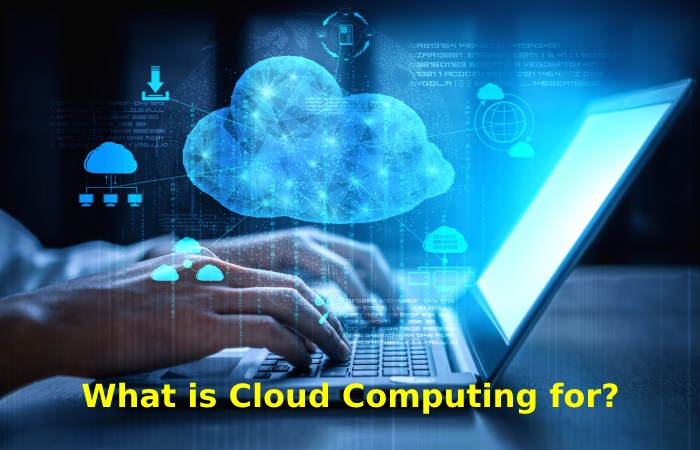Introduction
Cloud computing is a skill that allows remote access to software, file storage, and data processing from anywhere in the world at any time over the Internet without the need to connect to a local PC or server.
In other words, cloud computing uses the connectivity and vast scale of the Internet to host the widest variety of resources, programs, and information. It allows users to access them from any computer, tablet, or mobile phone.
If you’re still not clear, let me illustrate if you’ve ever edited a document in Google Docs, listened to music on Spotify, or watched a movies on Netflix, you’ve been directly exposed to cloud computing. . All of them are online services that do not require you to download, install and access any software or file on your computer. Instead, you only need a browser and a good internet connection to use them.
What is Cloud Computing for?

Let’s look at the traditional computing model, where users and businesses must invest in downloads, hardware, operating systems, and software to run any application. Then, it’s easy to see why cloud computing has become so popular.
The Cloud emerged as a way to democratize information and improve the experience of those who rely on technological resources on a personal or professional level.
Cloud computing has brought countless benefits. Opting for a cloud service enables
- Cost reduction through infrastructure: since there are no capital costs for the purchase of hardware and software, installation and maintenance;
- The centralization of information: prevent all data from being stored in different programs with different types of authentication and access;
- The increase or decrease according to the needs of the customer: thanks to the power of elasticity that provides the ideal amount of resources, storage, and processing;
- Remote work: Company employees can access any data from any computer, notebook, tablet, or smartphone as long as they are connected to the Internet.
In addition, we can mention the quality of security, the automatic updating of the server, the user-friendliness of the platforms, the technical assistance services, and backup copies.
With so many benefits, cloud computing has become the preferred option for most businesses and users. Not surprisingly, virtually everything we consume online today – social media, file storage, streaming video, and music – comes from applications and services hosted in the Cloud.
How does Cloud Computing work?
Cloud computing uses a remote server to connect user devices to centralized resources. A remote server stores all the data and programs you need, and it can be in your own country or on the other side of the world, for example, in Japan. You can access them online, from anywhere, even if they are stored miles away.
Also Read: Automated Trading System: Advantages and Disadvantages
Types of Cloud Computing Deployment Models
There are three systems of cloud computing: Public, Private, and Hybrid. If you’re a business considering using a cloud service, keep in mind that your choice will depend on costs, availability, performance, and expectations. Here’s how each Cloud works:
Private Cloud
The private cloud model refers to computing resources used exclusively in the same company or organization. The private Cloud can be stored in the internal data center, or a service provider can host it in the Cloud.
Public Cloud
When an organization implements a public cloud model, all hardware, software. And support infrastructure is own by the service provider that manages it and provides it exclusively over the Internet. You can access these services and manage your account using a web browser.
Hybrid Cloud
A hybrid cloud computing model chains public and private clouds toward sharing data and applications. Hybrid clouds attach infrastructure and applications between cloud resources with existing non-cloud resources. This approach gives your business more flexibility and more deployment options.
What services does cloud computing have?
Cloud computing services offer suitable pay-as-you-go models that eliminate costly expenses and maintenance. In addition, cloud providers host a variety of infrastructure, platforms, and software offerings in locations that they “rent,” giving a business the flexibility to turn cloud services on or off as needs change.
Infrastructure as a Service (IaaS)
Think of IaaS as the component of cloud-based computing. In this typical, a cloud provider hosts infrastructure components traditionally stored in on-premises data centers. For example, the server, storage, and network hardware, as well as the hypervisor (virtualization layer), are often hosted on-premises. With IaaS, your group can choose when and how to manage workloads without purchasing, collecting, and supporting the underlying infrastructure. Instead, IaaS gets infrastructure up and running quickly with a pay-as-you-go model.
Platform as a Service (PaaS)
PaaS complements the IaaS model but is often specific to hardware and software tools for application development. For example, in addition to providing infrastructure components. Cloud providers also host and manage the operating systems, and middleware developers need to build and run applications. As a result, PaaS offers a pay-per-use, on-demand model.
Software as a Service (SaaS)
With SaaS, cloud providers host and manage all end-user infrastructure and applications. If your company chooses a SaaS model. You don’t need to install anything; Users can log in and immediately start using the cloud provider’s application on the infrastructure. With SaaS, you can think about how your company will use this software instead of maintaining it. SaaS is available on demand or by subscription.
Conclusion
Now that you have understood the concept of cloud computing. Before thinking about the best model for your business, I recommend you think about your business’s needs and priorities because based on that, you will decide which services are essential and which ones you have. So you need that kind of investment.
Defining the available budget will help you choose the best system to implement: SaaS, PaaS, or IaaS. Next, analyze the features and functions you need and find providers that offer them, e.g., B. Cryptography and other security methods, effective backup services, 24/7 technical support, etc.
Also Read: What is the MWM? Mobile Workforce Management
Related posts
Featured Posts
StopWatt Reviews – The Most Effective Method to Save Energy
Are you ready to step into a brighter future of energy efficiency? Say hello to Stop Watt, the revolutionary energy…
Tips to Survive Crypto Bear Market
Introduction crypto bear market: Crypto investors and traders have started on the right foot. Even going out of their way…


